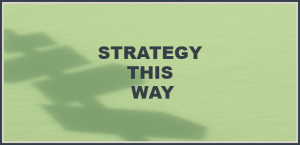3 Keys to Discover Strategic Marketing Process that Works
Being to begin
Currently I am teaching a marketing strategy course for St. Joseph’s University in the Philadelphia area. I am extremely passionate about the value of well executed strategic marketing process, and whenever I teach the subject I am always struck by how nuanced the discipline can be. There are elements of art and science to getting strategic marketing right, and it takes practice to get to the point where one can adopt a standard process or method for arriving at a well crafted go to market strategy. And, perhaps more importantly, have the awareness and confidence to drive that plan across an organization.
These truths are always reinforced in the class room setting because reading from a  text about elements of the strategic marketing process, like market segmentation, situational analysis, or product decision criteria, does not really offer up an in depth or behind the scenes reality that the words on the page represent. In fact this is why case studies are so critical when learning marketing because the case study gives the student the opportunity to apply what they have learned. Implicitly this application teaches much more than the black and white of even the best text ever could.
text about elements of the strategic marketing process, like market segmentation, situational analysis, or product decision criteria, does not really offer up an in depth or behind the scenes reality that the words on the page represent. In fact this is why case studies are so critical when learning marketing because the case study gives the student the opportunity to apply what they have learned. Implicitly this application teaches much more than the black and white of even the best text ever could.
So how does one effectively prioritize application, and what steps should be taken to ensure the nuance of the strategic marketing process becomes clearer? There are 3 keys to use when honing one’s strategic marketing ability.
Pick a starting point: This is sort of a ‘begin with the end in mind’ sort of suggestion. There are so many entry points into the strategic marketing process and planning that it is easy to never properly get started out of indecision over what the best course of action might be. The key here is to not dwell on the starting point itself but that one is chosen. While most text books suggest a step by step approach for marketing, reality is that you are rarely awarded the luxury of having a clear beginning. Therefore simply chose the area that has the most and easily accessible information to begin. If you do not have enough data on current sales, for instance, then focus on an external situational analysis. If future product requirements are undefined and unclear, begin by evaluating how well you have your buyers defined. If your buyers are not well defined take a close look at the sales process to reconcile whether or not every buyer in the cycle exists in your strategy efforts. What will happen is that eventually it becomes clear where the best starting point tends to be and a process will slowly begin to show itself.
Seek Information Data must give way to information. The art of the strategic marketing process cannot exist if the science does not. Regardless of the starting point you’ve defined, or the process that you’ve developed, it is critical that you uncover as much detailed information as you can. Breakdown demographics, evaluating target company financials, look at operating expense, measure the sales pipeline and cycle speed, research industry trends, highlight economic conditions, and so on. Information will help to reinforce the story that is ultimately going to be used to advance the marketing strategy. It will also serve to highlight operational realities that will compliment or possibly limit strategic options. Information is key
Drive to simplicity The strategic marketing process and resulting strategy itself must be simple. It is necessary to go into the development of a go to market strategy understanding that you seek to define very simple statements of what the strategy actually is. The statements cannot be generic, ‘increase revenue by 10%’, but should be an easy representation of purpose and intent, ‘We will expand revenue per customer by introducing product/service that is targeted to their need for. . . ” Here is perhaps the hardest part. Crafting a simple statement of strategy is tedious. Someone needs to commit to its development and lead. Exercises to arrive at strategic statements are uncomfortable for most. The danger is that it becomes a word smithing exercise for the sake of word smithing. To avoid this, the process must constantly be reconciled with the information gathering conducted earlier. Additionally there must be a certain degree of emotional and cultural attachment to the eventual statement. Lastly, leadership absolutely needs to not only be supportive of the statement, but commit to help see through the implementation.
These three steps will serve to help you develop your strategic marketing process skill set. If you are not taking a course or have not you might be wondering where you can practice? Simply pick a public company in an industry you like and begin to craft a go to market strategy for them. Give it a try and let me know how it went.
Photo Credit: jenny downing

